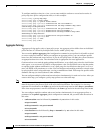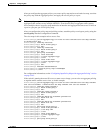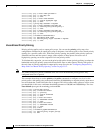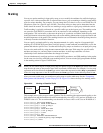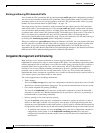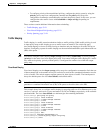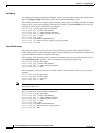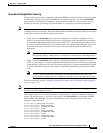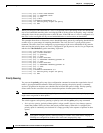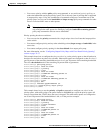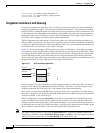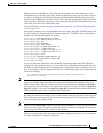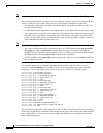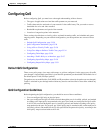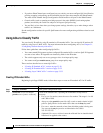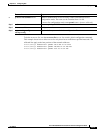
33-24
Cisco ME 3400 Ethernet Access Switch Software Configuration Guide
OL-9639-06
Chapter 33 Configuring QoS
Understanding QoS
Switch(config-pmap)# class class-default
Switch(config-pmap-c)# bandwidth 10000
Switch(config-pmap-c)# exit
Switch(config-pmap)# exit
Switch(config)# interface fastethernet 0/1
Switch(config-if)# service-policy output out-policy
Switch(config-if)# exit
Note When you configure CIR bandwidth for a class as an absolute rate or percentage of the total bandwidth,
any excess bandwidth remaining after servicing the CIR of all the classes in the policy map is divided
among the classes in the same proportion as the CIR rates. If the CIR rate of a class is configured as 0,
that class is also not eligible for any excess bandwidth and as a result receives no bandwidth.
This example shows how to allocate the excess bandwidth among queues by configuring bandwidth for
a traffic class as a percentage of remaining bandwidth. The class outclass1 is given priority queue
treatment. The other classes are configured to get percentages of the excess bandwidth if any remains
after servicing the priority queue: outclass2 is configured to get 50 percent, outclass3 to get 20 percent,
and the class class-default to get the remaining 30 percent.
Switch(config)# policy-map out-policy
Switch(config-pmap)# class outclass1
Switch(config-pmap-c)# priority
Switch(config-pmap-c)# exit
Switch(config-pmap)# class outclass2
Switch(config-pmap-c)# bandwidth remaining percent 50
Switch(config-pmap-c)# exit
Switch(config-pmap)# class outclass3
Switch(config-pmap-c)# bandwidth remaining percent 20
Switch(config-pmap-c)# exit
Switch(config-pmap)# exit
Switch(config)# interface fastethernet 0/1
Switch(config-if)# service-policy output out-policy
Switch(config-if)# exit
Priority Queuing
You can use the priority policy-map class configuration command to ensure that a particular class of
traffic is given preferential treatment. With strict priority queuing, the priority queue is constantly
serviced. All packets in the queue are scheduled and sent until the queue is empty. Priority queuing
allows traffic for the associated class to be sent before packets in other queues are sent.
Note You should exercise care when using the priority command. Excessive use of strict priority queuing
might cause congestion in other queues.
The switch supports strict priority queuing or priority used with the police policy-map command.
• Strict priority queuing (priority without police) assigns a traffic class to a low-latency queue to
ensure that packets in this class have the lowest possible latency. When this is configured, the
priority queue is continually serviced until it is empty, possibly at the expense of packets in other
queues.
Note You cannot configure priority without policing for a traffic class when traffic shaping or
CBWFQ are configured for another class in the same output policy map.



